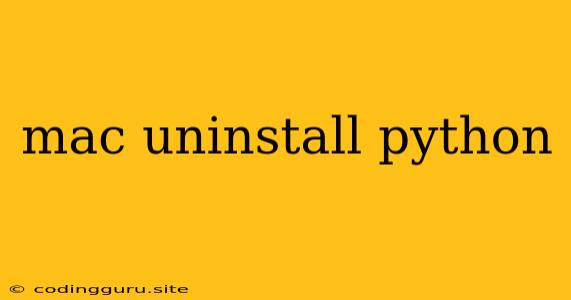How to Uninstall Python on Your Mac
Python is a versatile programming language used for various tasks, from web development to data analysis. But sometimes, you might need to uninstall it from your Mac. Maybe you're switching to a different version or you simply no longer need it.
Here's a step-by-step guide on how to uninstall Python from your Mac:
1. Identify Installed Python Versions
Before you start uninstalling, it's crucial to identify which Python versions are installed on your system. There are a few ways to do this:
- Using the Terminal: Open the Terminal app and type the following command:
python --version
This will display the version of the Python interpreter that's currently active in your environment.
-
Checking the Applications Folder: You can manually check the Applications folder for any Python-related apps. Look for folders named "Python" or "Python 3.x."
-
Using the Python Launcher: If you have the Python Launcher installed, you can use it to list all installed Python versions. Open the Launcher and click on the "Versions" tab. This will display a list of all installed versions.
2. Uninstall Python Using the Installer
If you installed Python using a dedicated installer package, you can generally uninstall it using the same installer.
- Locate the Installer: The installer file is usually located in your Applications folder or in the Downloads folder.
- Run the Uninstaller: Double-click the installer file to launch it. Follow the prompts to uninstall Python.
3. Manually Removing Python Files
If you don't have a dedicated installer, you can manually remove the Python files.
- Identify Python Locations: Python files are usually located in the following directories:
/usr/local/bin/usr/local/lib/python3.x/Library/Frameworks/Python.framework/Applications/Python.app
- Use the Finder: Open the Finder and navigate to these locations. You can use the "Go" menu and then select "Go to Folder."
- Delete Python Files: Delete all the files and folders related to Python. Be cautious while deleting files, especially if you're not sure about their purpose.
4. Remove Python Environment Variables
After removing Python files, you might need to remove Python-related environment variables. These variables tell your system where to find Python and its libraries.
- Open Terminal: Open the Terminal app.
- Edit the .bash_profile file: Type the following command to open your .bash_profile file in a text editor:
nano ~/.bash_profile
- Remove Python Lines: Remove any lines related to Python in the .bash_profile file, specifically those defining the PATH variable.
- Save and Close: Save the .bash_profile file and close the text editor.
5. Verify the Uninstall
After following these steps, you should verify that Python is completely uninstalled.
- Run the Terminal Command: Open the Terminal app and type the following command:
python --version
If the command returns an error or displays an unknown command, then Python is successfully uninstalled.
6. Uninstall Python Packages
If you installed Python packages using pip, you need to uninstall them separately.
- Open Terminal: Open the Terminal app.
- Uninstall Packages: Use the following command to uninstall specific packages:
pip uninstall package_name
Replace package_name with the actual name of the package you want to uninstall.
Important Considerations:
- Virtual Environments: If you were using virtual environments, removing the virtual environment folder will remove the Python installation associated with that environment.
- Python Frameworks: Some Python frameworks might require specific versions of Python. If you're using frameworks like Django or Flask, ensure their compatibility with the remaining Python versions on your system.
- Backup: It's always a good idea to create a backup of your important data before uninstalling Python.
Conclusion
Uninstalling Python from your Mac involves several steps, but by following these instructions carefully, you can remove it effectively. Remember to be cautious while deleting files and verify the uninstall process. If you encounter any difficulties, consult the official Python documentation for further assistance.
